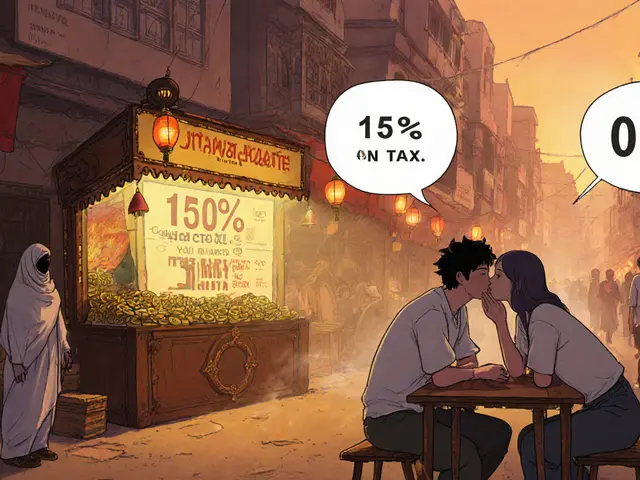SocialFi Monetization Calculator
Estimate how much you could earn on SocialFi platforms based on your current engagement metrics.
Enter your metrics to see estimated earnings
Everyone’s buzzing about how the next generation of social networks will hand power back to users. The promise? A web where you own your posts, your followers, and even the money you earn, all secured by blockchain. In 2025 that vision is moving from niche hobby projects to serious contenders for mainstream attention.
What is blockchain social media?
Blockchain Social Media is a decentralized ecosystem that lets creators publish content, interact with followers, and monetize directly through crypto tokens without a central gatekeeper. Also called SocialFi or decentralized social media, the model flips the classic platform‑owner relationship on its head. Instead of a corporation holding your data and deciding who sees your post, the blockchain records ownership of every piece of content and every social connection as a verifiable token.
Why the surge now?
Several forces converged in 2024-2025:
- Users grew tired of privacy scandals, algorithmic bias, and the 30‑50% revenue cuts imposed by giants like Instagram.
- Crypto wallets became as common as email addresses, making on‑chain payments frictionless.
- Layer‑2 solutions slashed transaction fees - Lens Network, for example, now charges under a tenth of a cent per interaction.
According to Blockleaders.io, the SocialFi market topped $1.2 billion in Q3 2024, with more than 15 million monthly active users across all platforms.
Key Players in 2025
Not every project is built the same. Below is a snapshot of the most influential platforms, their tech stack, and where they excel or stumble.
| Platform | Core Chain / Tech | Token Model | Active Users (2024) | Strengths | Weaknesses |
|---|---|---|---|---|---|
| Lens Protocol | Ethereum + Lens Network L2 | ERC‑721 profile NFTs + utility token (LENS) | 3.2 M profiles, 47 dapps | Composable social graph, developer‑friendly | Legacy gas spikes on Ethereum mainnet |
| Farcaster | Ethereum (HPN) + IPFS storage | ERC‑20 & ERC‑721 post tokens | 5 M daily posts | Vibrant creator community, fast app updates | Requires crypto wallet for every user |
| Bluesky | AT Protocol (mix of decentralised & hosted) | No native token (pay‑to‑post via BSKY credits) | 10 M users (Dec 2024) | Familiar UI, low entry barrier | Still semi‑centralised governance |
| Hive | Delegated Proof‑of‑Stake (DPoS) | HIVE token for rewards | 1.2 M daily active users | Instant, fee‑free transactions | Older UI, slower feature rollout |
| Diamond App | DeSo blockchain | Creator‑coin model (each user issues a token) | 450 K active users | Deep monetisation tools for creators | Wallet‑fatigue, occasional app crashes |

Technical Foundations That Make It Tick
Behind the glossy interfaces lies a stack of protocols that solve three classic problems: identity, data storage, and transaction costs.
- Decentralised Identifiers (DIDs): Standards from the W3C let users link a single cryptographic key to multiple platforms, creating a portable social graph.
- Content addressing: IPFS and Arweave store posts off‑chain while leaving a hash on the blockchain, guaranteeing immutability without bloating the ledger.
- Layer‑2 scaling: Solutions like Optimism, Arbitrum, and the bespoke Lens Network compress hundreds of interactions into a single cheap batch transaction.
These pieces work together so that a creator can mint a profile NFT on Lens Protocol, post a picture stored on IPFS, and receive a LENS token tip in under a second for a fraction of a cent.
How Creators Monetise on SocialFi
Monetisation is the biggest draw for early adopters. Four main mechanisms dominate:
- Direct tips: Fans send native tokens (e.g., LENS, HIVE) to a post they like.
- Creator coins: Platforms like Diamond let a creator issue a personal token whose price reflects demand.
- Revenue sharing: Some dapps allocate a slice of ad‑type impressions to token holders.
- NFT collectibles: Limited‑edition NFTs tied to a post can be sold or auctioned.
A real‑world case: CryptoCreator89 reported earning $3,200 in six months on Lens by issuing limited‑edition NFTs and receiving tip bundles, compared with $420 on Instagram for the same follower count.
Barriers to Mass Adoption
Despite the hype, several friction points keep SocialFi from mainstream dominance.
- Wallet fatigue: A Backpack Exchange survey found 63 % of users juggle three or more wallets, and 78 % abandon sign‑up at the wallet‑creation stage.
- Usability gaps: Wired scored Lens on a 7.2/10 difficulty scale versus 2.1 for Instagram - the learning curve still feels like a tech‑startup tutorial.
- Regulatory uncertainty: The SEC’s 2024 framework flagged creator‑share models (e.g., Friend.Tech) as potential securities, prompting a 30 % drop in active wallets.
- Content quality: Token incentives can fuel spam; early Steem data showed 37 % of high‑reward posts were low‑effort memes.
Solutions are emerging. Bluesky introduced email‑based onboarding that lifted completion rates to 67 %, while Backpack Exchange’s unified wallet reduces steps from five to three. Protocol Labs is trialling AI‑driven moderation for the Fediverse, aiming to curb low‑quality content without central censorship.

2025 Outlook - When Will SocialFi Go Mainstream?
Analysts disagree on timing, but most agree 2025 is a pivot year.
- Gartner’s Hype Cycle places decentralized social media at the "Peak of Inflated Expectations," forecasting mainstream adoption between 2027‑2030.
- Deloitte predicts SocialFi could capture 15‑25 % of the $207 billion traditional ad market by 2027 - a modest slice, but enough to attract venture funding.
- Consensys gives a 72 % probability of reaching 10 % market share by 2030, provided usability hurdles drop below a 30 % abandonment rate.
Geographically, Southeast Asia is leading growth (42 % YoY) thanks to crypto‑friendly regulations, while North America remains cautious due to tighter securities laws. Enterprise pilots, such as Fortune 500 firms testing private Lens instances for internal comms, hint at a future where hybrid on‑chain/off‑chain workflows become normal.
How to Jump In - A Step‑by‑Step Starter Kit
- Download a reputable non‑custodial wallet (e.g., MetaMask, Rainbow).
- Fund it with a small amount of the platform’s native token - for Lens, buy a few LENS on a major exchange.
- Visit the platform’s onboarding page. Bluesky lets you sign‑up with an email; Lens will prompt you to connect your wallet.
- Create a profile NFT. On Lens this is a one‑click transaction that mints an ERC‑721 representing your identity.
- Start posting! Attach IPFS hashes to your media, and enable tip options in the post composer.
- Explore monetisation tools - set up a creator‑coin on Diamond or mint a limited‑edition NFT on your chosen platform.
Pro tip: Use Backpack Exchange’s unified interface to manage multiple platform wallets from a single dashboard - it cuts the onboarding time from hours to under thirty minutes.
Key Takeaways
- Blockchain social media is shifting from niche experiments to viable alternatives for creators.
- Lens Protocol, Farcaster, and Bluesky dominate the space, each with distinct tech and monetisation models.
- Usability, regulation, and content quality remain the biggest barriers.
- 2025 is a critical inflection point; early adopters who master the tech will reap the biggest rewards.
What is the difference between SocialFi and traditional social media?
SocialFi stores ownership of profiles, posts, and interactions on a blockchain, letting users earn crypto directly. Traditional platforms keep data on central servers, monetize through ads, and take a large cut of creator earnings.
Do I need to know how to code to use Lens Protocol?
No. Lens offers web‑based clients like Lenster where you can sign up with a wallet and start posting without writing any code. Developers can build custom apps on top of the protocol, but creators can stay on the ready‑made UI.
Are tokens earned on SocialFi platforms taxable?
In most jurisdictions, crypto earnings are treated as ordinary income or capital gains. Users should consult local tax advice and keep records of token receipts and conversions.
Can I move my social graph from one platform to another?
Interoperability is still limited, but projects like the W3C Decentralized Identifiers v2.0 aim to let a single DID link to profiles on Lens, Farcaster, and other networks, making migration easier in the future.
What security risks should I watch out for?
Losing your private key means losing access to your content forever. Always back up seed phrases offline, use hardware wallets for large balances, and beware phishing sites that mimic legitimate login pages.






Karla Alcantara
October 26, 2025 AT 09:44 AMI'm really excited about the momentum behind SocialFi right now. The way creators can finally own their content feels like a breath of fresh air for the whole digital culture. As we see platforms like Lens and Bluesky gaining traction, the community vibe is becoming more inclusive and supportive. Keep experimenting, share your experiences, and let's build a space where everyone feels welcome to express themselves.
Jessica Smith
October 27, 2025 AT 19:04 PMPeople keep pretending this is just a hype cycle. In reality it's a reckless gamble on untested tech. Anyone who ignores the obvious risks is just naive.
Manish Gupta
October 29, 2025 AT 04:24 AMIt's fascinating how quickly wallet adoption has surged :) The decentralized identifiers are finally giving users a portable identity. Seeing the rise of creator‑coins shows real economic incentive at work :) I think this will reshape how we think about online reputation.
Gabrielle Loeser
October 30, 2025 AT 13:44 PMFrom a mentorship perspective, the evolution of SocialFi presents valuable learning opportunities. Developers and creators alike should consider the interoperability standards such as DIDs when designing their applications. Moreover, understanding the token economics can help in crafting sustainable monetisation models. I encourage all participants to engage respectfully and explore collaborative solutions.
Rampraveen Rani
October 31, 2025 AT 23:04 PMLet's dive in! 🚀💥
Sarah Hannay
November 2, 2025 AT 08:24 AMWhile I respect the caution expressed, it is essential to acknowledge the genuine innovation unfolding within blockchain social platforms. Dismissing them outright overlooks the concrete improvements in user ownership and data privacy. Constructive dialogue can bridge the gap between skepticism and adoption. Therefore, I propose a balanced assessment rather than blanket condemnation.
John E Owren
November 3, 2025 AT 17:44 PMGreat enthusiasm! If you’re just starting, try creating a simple profile on Lens and experiment with a small tip transaction. This hands‑on approach will build confidence and showcase the real benefits. Remember, the learning curve flattens quickly once you’ve taken that first step. Keep it up, and you’ll become a seasoned creator in no time.
Joseph Eckelkamp
November 5, 2025 AT 03:04 AMOh, what a surprise, another “revolutionary” platform promising to hand power back to users, as if we haven’t heard that line a hundred times before. The notion that decentralized identifiers will magically solve identity theft is, frankly, a delightful fantasy, complete with glittering unicorns and rainbows. And let’s not forget the charmingly low transaction fees, which, according to the latest reports, are about as low as a hamster’s paycheck. Of course, the real magic happens when you mint an NFT profile and instantly become the digital aristocrat of the internet. One can only marvel at the elegance of paying a fraction of a cent for a tip, while simultaneously grappling with the existential dread of losing your private key. It’s truly heart‑warming to watch users juggle three or four wallets, a habit that surely boosts cognitive flexibility. The regulatory environment, with its gentle nudges from the SEC, adds just the right amount of excitement to the mix, reminding us that nothing says “fun” like potential securities litigation. Content quality, of course, skyrockets as creators race to out‑spend each other in meme production, a true testament to the altruistic nature of token incentives. The user experience, rated a modest 7.2 on the difficulty scale, ensures that only the most dedicated survive-a perfect filter for genuine talent. Meanwhile, the lack of a central gatekeeper guarantees that every piece of content, no matter how low‑effort, finds its audience, because algorithms are sooo 2023. One must also applaud the visionary developers who chose to build on Ethereum, despite its notorious gas spikes, because nothing says “scalable” like waiting for block confirmations. The promise of hybrid on‑chain/off‑chain workflows is as clear as mud, yet we march onward with unwavering optimism. In a world where every post can be tokenised, the line between creator and investor blurs into an indistinguishable haze of financial speculation. The social graphs, now portable across platforms thanks to DIDs, will undoubtedly eliminate any friction, because portability is a myth we’re all eager to chase. And finally, the idea that by 2030 we’ll capture a meaningful chunk of the ad market is not just plausible, it’s practically guaranteed-provided we forget to consider user adoption rates entirely.
Dimitri Breiner
November 6, 2025 AT 12:24 PMI see where you’re coming from, and while the sarcasm is appreciated, there are legitimate use‑cases worth exploring. The tokenised content model can indeed empower niche creators who struggled with traditional platforms. If we focus on improving onboarding and reducing wallet complexity, the barrier you mentioned could be lowered significantly. Let’s keep an eye on emerging tools that aim to simplify these experiences.
Patrick Rocillo
November 7, 2025 AT 21:44 PMWow, talk about a roller‑coaster of hype and reality! 🎢💥 Your tirade painted a vivid canvas of chaos, yet amidst the fireworks there’s a splash of truth. The glittering promise of decentralisation does sparkle, but the potholes are real. 🌟🚧 Still, those brave early adopters are the bold artists splash‑painting the future, emojis and all! 🎨🚀
Nisha Sharmal
November 9, 2025 AT 07:04 AMOh sure, let’s all sit around the global table and pretend every platform is equally regulated. In reality, only the western‑centric models understand real compliance, and the rest are just playgrounds for crypto‑wannabes. If you think “interoperability” will magically fix everything, you’re living in a fairytale.
Sonu Singh
November 10, 2025 AT 16:24 PMyeah, i get what you r sayin, but honestly the whole “one size fits all” thing is kinda wack. each platform got its own vibe and ya cant force a single rule set on ’em all. maybe just chill and let the market sort it out.